With a range including DC, Top Cow/Image, Dark Horse, and Marvel, here’s the recap of November 2017 for comic books. There were also a multitude of television releases and other things, but let’s stick to just the books.
Best Issue: “Batman: Lost” #1
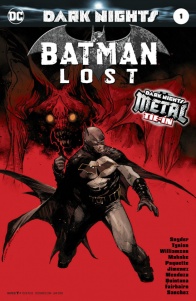
This entire issue, part of the ‘Dark Nights: Metal’ event, is interesting for its style of storytelling as much as its content. With highly varied scenarios, including three writers (Scott Snyder, James Tynion IV, and Joshua Williamson), three illustrators (Doug Mahnke, Yanick Paquette, and Jorge Jiménez), and three colorists (Wil Quintana, Nathan Fairbairn, and Alejandro Sanchez), the team manages to not only bring together a vast array of stories stretching from ‘The Case of the Chemical Syndicate’ to ‘The Return of Bruce Wayne’ to ‘The Court of Owls’, but also to reinvent the very nature of Batman himself, of his identity and origins.
The connections to a mystical force are not exactly unique, as they were previously shown in stories such as that of Shadowpact villain “Doctor Gotham,” but the method through which Gotham City itself, along with the Batman and the Wayne Family, are connected in a virtual apocalyptic scenario remains horrific.
The entire story is akin to an extremely nightmarish incarnation of going down the rabbit hole, further and further into the chaos of the Dark Multiverse. The further it goes, the creepier, the scarier it gets until it comes to its culmination, one of utter despair that leaves readers wanting more nonetheless.
Best Writer: Tom King (“Mister Miracle” #4)

Through a mixture of the calm atmosphere of Scott’s home with Barda and the liberal use of beat panels, King manages a rather comedic atmosphere in spite of the seriousness of the charges lain against him by the replacement for Highfather, Orion, such as Scott calmly getting up to grab a carrot after being told of the seriousness of the trial he is undergoing.
That said, King is able to create a wide variety of emotional responses. Orion’s blatant kangaroo court as judge, jury, and executioner given by his abuse of Izaya’s laws is intentionally infuriating, given his decision to take up the role of defense, prosecutor, and judge simultaneously makes the outcome of the trial practically preordained. The thing that allows King to keep this truly abominable is the sheer ruthlessness with which Orion verbally assaults Scott, using Orion’s own biases as he remains relatively calm in the “assertion” that his trial is just and fair.
Furthermore, the entire issue allows for an underlying feeling of horror as the forces of Apokolips continue to have a grasp on the mind of the God of Freedom, even in his own home. Scenes such as the appearance of Granny Goodness or a single black panel with nothing but the words “Darkseid Is” give a feeling of dread, of the inevitability of the threat of Apokolips and the sheer magnitude of the threat that New Genesis faces on a near daily basis, almost granting a semblance of validity to Orion’s attempt to root out the Anti-Life Equation.
Best Artist: Hendry Prasetya (“God Complex” #2)

Down in the streets, the view is typical of many cyberpunk dramas, with glaring, distracting lights keeping attention away from the dour surroundings. However, the interesting part comes in with how it is drawn. The artistry is intentionally indistinct around the edges, with exception made for neon signs. In fact, the glow of neon lights actually projects a kind of glare over those caught outside, making the state of being out in the world disorienting and distracting. Even where there are not many different lights, there is still a sense of the surroundings being very unimportant, but simultaneously oppressive, on account of relatively indistinct linework. In these processes, Prasetya manages to pull off the same aesthetic and attention grabbing of a live action cyberpunk story, while also merging in some of the styles of a cartoon such as the aforementioned glow over individuals.
Continued belowInside a building, everything is clearer, with thicker lines and softer tones. As the style is closer to that used on actual people, the implication seems to be that they belong inside, rather than out in the world.
An overview of the city from the perspective of a skyscraper shows a merger of two different styles altogether. The view of the outside is similar to in the streets themselves, whereas the attention within the building gives a mix of a very lifelike reflective floor and the thicker lines of walls and tables. Through this process, Prasetya further distinguishes between the different settings.
The gods themselves run a gamut from being humanoid enough to be drawn in a similar style to humans and the Fates, who have two different styles. The statue of them, with its curves and thicker lines, is so close to reality that it seems to actually be unreal by comparison to the rest, dipping intentionally into the uncanny valley. On the other hand, their actual forms, those of data, are formed of a variety of the very lights outside, similar to the view of cyberspace. This setting is very interesting in its view, just barely understandable to the human eye, and gives readers an even greater reason to follow this series.
Best Video Game Tie-In: “Tomb Raider: Survivor’s Crusade” #1
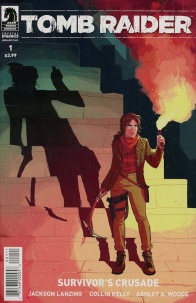
The main focus here is in what is most accessible to others who may have not played the games, while still having an interest for those who do, as well as those who have or have not read previous volumes of the comics themselves.
“Tomb Raider: Survivor’s Crusade” #1 fills that interesting cross between the comic continuation and the game adaptation. For readers of the comics, it is merely a continuation of what had come before, albeit taking place after the games. Everything in it makes sense from that perspective, including the identity the person Lara Croft calls her best friend. For players of the games, it works as a way to answer lingering questions, specifically who exactly did kill Lord Richard Croft and, presumably, some of how deep Trinity runs into the Croft legacy.
From the perspective of a newcomer, it works in another way. By combining Ms. Croft’s resourcefulness in combat, athleticism, and intelligence in the present with her indecisiveness and concern in the messages she leaves for her friend, readers who are new to this version of Lara Croft are brought into her world, learning her physical and intellectual capabilities alongside her emotional capacity and interpersonal connections.
Best One-Shot: “The Batman Who Laughs” #1
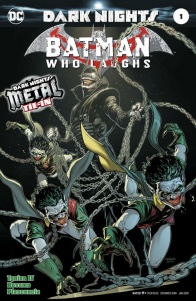
While James Tynion IV already has a creepy character to work with, his writing slowly brings this psychotic Batman about, jumping ahead in small amounts as Tynion hones in on key moments in his development. The process is shown in horrifying detail, from Batman laughing at inappropriate times and being horrified up until his brutal murder of his closest friends to prevent them from stopping his transformation. Furthermore, the addition of the bandaged man in the chair gives an added air of mystery, in much the same way as 2013-2014’s “Forever Evil” storyine.
Slowly, the illustrations of Riley Rossmo, colors of Ivan Plascencia, and lettering of Tom Napolitano bring together the remainder, showcasing the slow but steady descent into madness as first Batman’s facial expressions, then his face’s makeup, and finally his costume change, the rest of the world being relatively stable in the grand scheme of things.
Continued belowWhile this one-shot was hyped up significantly by Scott Snyder beforehand, Tynion and his team definitely delivered nonetheless.
Best Character Development: John Jonah Jameson Jr. (“Peter Parker: The Spectacular Spider-Man” #6, #297)


In these two issues of “Peter Parker: The Spectacular Spider-Man,” Chip Zdarsky reforges the man into a tragic figure, one haunted by the death of his father, daughter, and wife, and rejected by the Daily Bugle to the point that he has to keep up his vendetta on a blog nobody even reads. As he himself admits, Jameson has nothing left but his own hatred of Spider-Man, his desire to “hold him accountable,” even if it’s killing him from the inside out. Yes, he’s done horrible things, chased the wrong man, but by showing both sides of the story, showing how and why Spider-Man and Jameson hate each other’s actions, they aren’t very different in some ways. By the end of the interview in issue #6, Jameson is sobbing uncontrollably. The pain is so much that even people who hate Jameson are likely to be sympathetic to his plight, even if they revile his methods.
It is so bad that Peter, wanting to console him, voluntarily gives up his secret identity, showing his face in full. And what does Triple J do with this knowledge? Does he faint and/or yell at him, as he would have back in “Civil War?” Does he act with unwavering kindness as he may have in the Ultimate universe? No, he doesn’t do either, but his response is nonetheless relatively realistic and even commendable. Once the shock wore off, he drove after Parker, finding him, and saved his life from a Grey Blade agent, hitting the latter with his car. From enemy to ally, albeit one with a very reasonable chip on his shoulder. What makes his change even more reasonable, even justifiable, is his talk with Parker in his car after saving him.

All things considered, he’s got a valid point. Spending so much money on what were essentially selfies, and thus took pretty much no real effort in finding Spider-Man, does amount to some kind of fraud and a waste of his resources.
Here’s hoping this way of dealing with J. Jonah Jameson continues, but given this isn’t meant to be up to date with the current comics, but shortly before the most recent volume of “Amazing Spider-Man,” it’s sadly unlikely that Dan Slott will keep to the great development here.
Weirdest Heroic Loss: Hal Jordan/Green Lantern vs. Bruce Wayne of Earth -32/Dawnbreaker (“Hal Jordan and the Green Lantern Corps” #32)
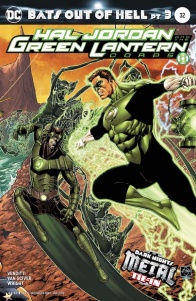
By contrast, the fact that the Dawnbreaker relies upon the technological means of the Green Lanterns, along with the fact that he is far less competent on account of never having been Batman before he got the ring (and thus not learning nearly as much), means that he is probably the weakest, even if he has a strong weapon. For that reason, Hal Jordan’s defeat by him, as the focus of the main fight shown in ‘Bats out of Hell,’ serves only to cheapen the experience.
Hal starts the fight by acting smart, by using his “strobe” function in his own ring to make sure that his opponent has no way of actually catching and absorbing the light of his ring with Earth -32’s own corrupted ring. He manages to beat up the Dawnbreaker, and even seems to be winning…
Continued below…but then he decides to turn off the strobe function to stand around and gives a speech about how awesome he is, his light continuously on and thus able to be countered and absorbed to leave him powerless (again). What exactly is the point of that? “I’m going to just give up my one advantage, since I was a Green Lantern far longer than you have had your ring and thus know more about how it works normally.” The outcome from there is so obvious that after the speech, it cuts immediately to him having been defeated by the Dawnbreaker. The Dawnbreaker’s victory seems written in such a way that it is just a means to finish up the issue, rather than have some method of the Dawnbreaker show some other ability to overcome the strobe countermeasure.
Saddest Family Reunion: Jor-El and Kal-El (“Action Comics” #991)
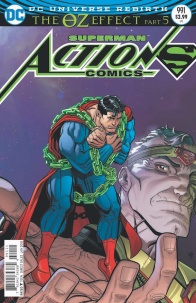
Jor-El was infected by the Kryptonite lodged in his eye (seen on the cover), giving him what could be considered a Kryptonite brain cancer. The staff he held seems to have been granted by Doctor Manhattan to both regulate the effects of the Kryptonite and control his perspective to see humanity for its worst. The true sadness comes in with the destruction of the staff, as Jor finally realized the full horror of what he had been doing. He wanted nothing more than to protect his son and his son’s family, and seemed to have regrets for what he had to do to protect them, but he seemed to fully realize what he was doing when he used his Kryptonite vision on Kal, poisoning and attacking him to “protect” him for his own good. Upon realizing how corrupted he truly had become, Jor seemed so pathetic that being embraced by his son seemed reasonable. As Clark Kent as much as Kal-El, Superman aims to help people, not by abandoning those who are in pain, but by stopping violence and helping others to be better. Unfortunately, as their conflict is heating up toward “Doomsday Clock,” Doctor Manhattan had another idea, and dragged away Jor-El before he could be given any kind of treatment by Superman or his family and friends.
The tragedy is that we have no way of knowing if he will ever be seen again. If he is, he is likely to be destroyed by Doctor Manhattan as a failed experiment, much as he temporarily killed Eobard Thawne in “The Button.” Jor-El really did want to be a good father. He just had no idea how to do so, and his mental illness wouldn’t allow him to see things any other way.






